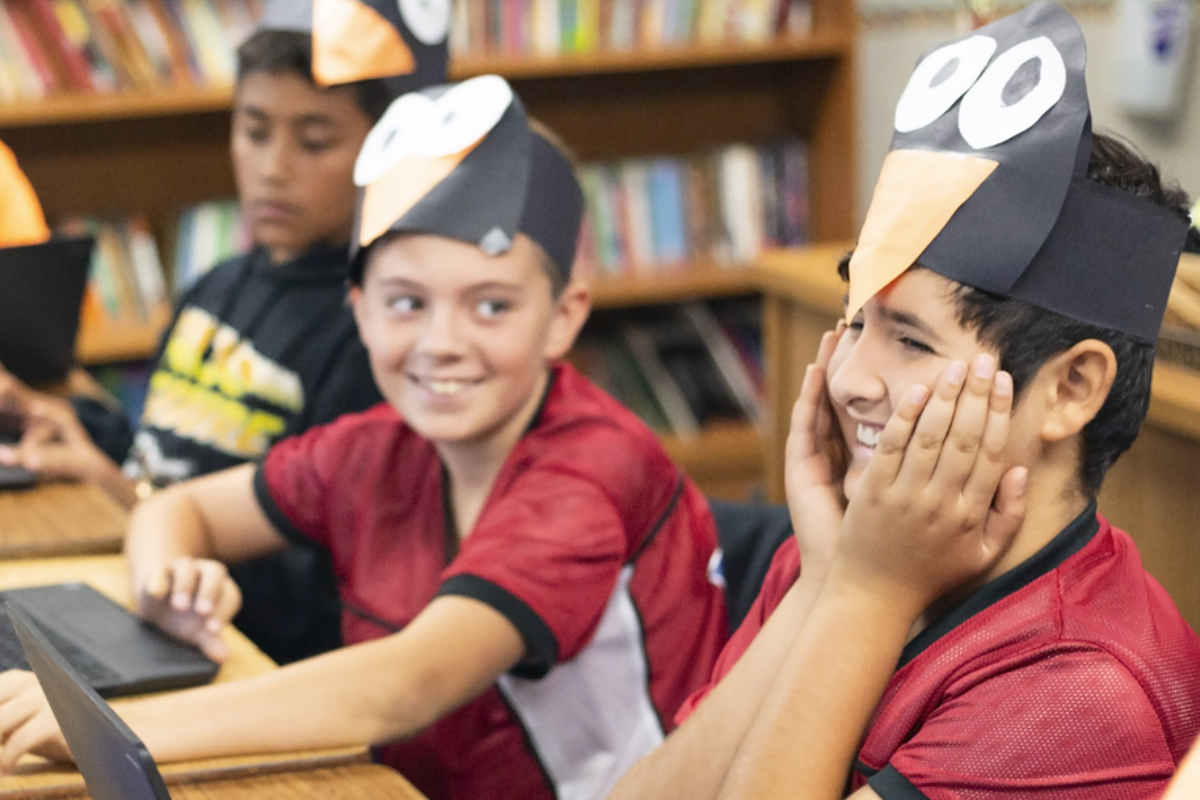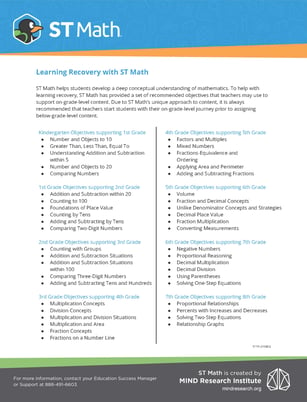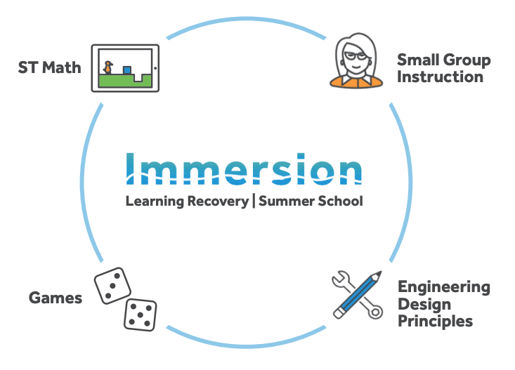Those of us in education were in a very different place last year. Research on COVID-related school closures estimated that students would be a half to a full year behind academically when the new school year begins.
We've seen firsthand the impacts of what many experts refer to as the COVID Slide. Inconsistent instructional formats and inequitable access to essential technology, among other equity gaps, have contributed to widespread signs of reduced learning, especially for low-income and special education students.
But with the recent passage of the American Rescue Plan, schools and districts alike now have access to significant federal funds to recover lost learning this summer.
ST Math can make a positive impact for students as we work toward learning recovery and to regain ground in the new school year.

ST Math begins by showcasing math visually, and then gradually introduces symbols and language as students master the basic concepts. Using visual, spatial-temporal models to showcase the math concepts provides students with access to mathematical ideas in ways that words alone cannot achieve.
With visual learning, students are better equipped to tackle unfamiliar math problems, recognize patterns, and build conceptual understanding. When we remove language as a barrier, the problem is accessible to more students, regardless of skill level or language background.
ST Math is self-paced. Students move through the instructional path at their own speed. By applying a mastery-driven approach, each student receives a personalized number of puzzles to solve based on their level of understanding of each topic. This allows students to be presented with the right amount of challenge and support for their level.
Many digital programs use adaptive algorithms to adjust the level of instruction up or down based on students’ right or wrong answers. Typically, struggling students get tracked to below grade-level material, and they can get stuck there.
Not so with ST Math. Rather than automatically dropping students down, ST Math starts each concept at a very basic level and gradually increases the level of challenge using scaffolding techniques. Instead of going backwards to experience success, ST Math’s approach enables students to access on-grade-level material in ways not possible with traditional approaches to math instruction. This allows all students to begin on grade level and meaningfully progress through the mastery-driven content at their own pace.
The ST Math assignments feature gives teachers the ability to select specific ST Math objectives to assign to individual students, small groups, or the whole class. Objectives can come from any grade level, and can be used to augment and fortify conceptual understanding of topics from earlier grade levels, or to challenge students with material from later grade levels.
Educators who have already been using ST Math will find that students won’t replay objectives that they have already mastered in prior grade levels. This ensures that each student gets only the review they need, and is an encouraging indication that the student has developed a deep understanding of the content and is ready to succeed at their grade level in ST Math.
For students who are most impacted by the COVID Slide, it may be beneficial to consider assigning particular content from the prior grade. We always recommend that teachers start students with on-grade-level content, but should students need to deepen conceptual understanding of earlier concepts, the ST Math team has put together a suggested list of objectives for teachers to assign at their discretion:
Kindergarten Objectives supporting 1st Grade
1st Grade Objectives supporting 2nd Grade
2nd Grade Objectives supporting 3rd Grade
3rd Grade Objectives supporting 4th Grade
4th Grade Objectives supporting 5th Grade
5th Grade Objectives supporting 6th Grade
6th Grade Objectives supporting 7th Grade
7th Grade Objectives supporting 8th Grade
 Download these recommendations on a single page (PDF)
Download these recommendations on a single page (PDF)
Whether educators keep students on grade level content or use the new assignments feature to draw in content from other grade levels, ST Math can make a positive impact for students in mitigating learning loss and regaining ground in the new school year.
 Learning Recovery - this Summer and Beyond
Learning Recovery - this Summer and BeyondDid you know that MIND offers a K-5 blended learning curriculum for learning recovery? ST Math Immersion can be used as an intensive program for extending the year, as a school year jumpstart, or as a summer program.
The curriculum is designed to be used in 90-minute math blocks, 5 days per week, for 5 weeks. It addresses common areas students struggle in, with grades K-2 focused on operations and algebraic thinking, and grades 3-5 focused on fractions.
Check out the ST Math Immersion flyer to learn more about the program.

Ki Karou is the Director of Product, ST Math Content at MIND Research Institute.
Comment